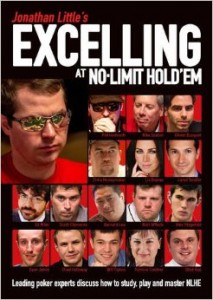INTRODUCTION
Like it’s inspiration Super System by Doyle Brunson, Jonathan Little’s Excelling at No Limit Hold’Em is a cornucopia of a poker book. It has chapters by a mixed bag of known poker professionals from the old school elites to the new kids on the block. This book has a little something for everyone, which sort of implies that not every chapter will appeal to all readers. I found this to be the case for me. There were some chapters that I absolutely loved and others I simply could not wrap my head around. Fortunately, the former was more prevalent than the latter.
 PART I: POKER STRATEGY
PART I: POKER STRATEGY
This section, featuring chapters by authors Evan Jarvis, Chris Moneymaker, Ed Miller, Scott Clements, Matt Affleck, Bernard Lee, and Zachary Elwood, was one of my favorites. These chapters were easy to read and they both introduced me to new concepts and reiterated ideas that I already believed to be true. Evan “Grisped” Jarvis stressed the importance of concepts like equity, position, and aggression. Chris Moneymaker discussed the difference between high stakes tournaments and low stakes tournaments. These guys opened my eyes to some new ideas that I could immediately put to use. Ed Miller discussed moving up in live cash games and Zachary Elwood discussed poker tells. Their sections kind of summarized ideas I learned after reading their latest solo books. I was happy to see that Little was cool with allowing these guys to plug their own products in his. They give you the tip of the iceberg, but I suggest checking out their personal offerings for a more in depth discussion on the topics.
My favorite chapter of this section was the one written by Scott Clements. It was a barrage of jewel after jewel and read as if he’d just started playing a session and wrote down everything he thought about. The biggest take away I got from him is to start with a tight solid game while paying attention and picking up reads on your opponents. Once you know how they play, make the obvious adjustment. If they are too tight, bluff them. If they are too loose, value bet or trap them. Poker really feels simple when you think about it in these terms. The key is to pay attention to the hands you’re not in, which is something most of us multi-tabling Twitter addicts just cannot seem to do.
PART II: THE TECHNICAL GAME
I had mixed feelings about this section which features chapters by authors Alex Fitzgerald, Phil Helmuth, Liv Boeree, Jonathan Little, Olivier Busquet, and Will Tipton. On one hand, it includes the book’s best chapter written by Alex “Assassinato” Fitzgerald. On the other hand, it includes a chapter by Will Tipton who is a much smarter player, but in my opinion, not as good of a teacher.
Fitzgerald puts on a clinic in his chapter. Section I on this book contains easily digestible topics that pretty much anyone can benefit from. Section II got into a lot of the nitty gritty that can often go over the heads of recreational players like me. Fitzgerald understood this because, admittedly, he was once a numskull as well. He worked harder than the poker savants who seemingly were good from birth and therefore knows how to build a successful player from the ground up. This understanding helped him to slow down and make sure to focus on the most basic concepts that are the building blocks of seemingly complicated range based mathematical play. He does a great job of explaining what’s important about ICM, invaluable learning tools like Flopzilla, bet sizing, and combinatorics.
Will Tipton’s chapter on GTO strategies was the one I got the least from. This is a complicated topic and Tipton is a very smart man. At times, this seemed to cloud his ability to dumb the topic down into language idiots like me could understand. Being a genius, he seemed to be focused on abstract concepts that he found interesting and promised to “cover a practical skill or two” as sort of an after thought. He really lost me when he said “A GTO strategy can involve folding the nuts, even on the river.” At that point, I gave up trying to understand what he was saying or why he chose to discuss something so far from reality. To his credit, he acknowledged that GTO is less useful for those who play MTTs. Since this is my focus, I am comfortable with leaving this discussion to those who have the capacity to understand it and the need to use it.
PART III: THE MENTAL GAME
The final section of the book included chapters by mental game experts Dr. Tricia Cardner, Jared Tendler, and Elliot Roe. For the most part, the ideas they presented were fairly easy to understand. Cardner focused on being mentally tough which is paramount to poker success. Tendler identified the seven types of tilt and summarized his method for controlling it. Roe explained that real hypnosis is not the parlor trick that we remember from TV, but is simply guided meditation. I was able to get concrete, usable strategies from each of these three chapters.
CONCLUSION
Overall, I highly recommend Jonathan Little’s Excelling at No Limit Hold’Em for virtually any poker player. However, I would caution readers to use it as more of a reference book than a cover to cover read. Think about what areas you need to improve in your game, then turn to the appropriate chapter. Once you are ready to move on, repeat that process and move to the next chapter that is applicable to you. I got much more out of this book by skipping around in that manner and I think you will as well.


